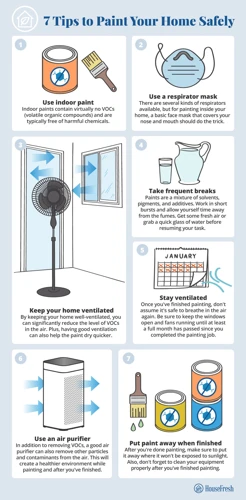Starting a new interior painting project can transform the look of any space, but it’s crucial to consider more than just color choices and paint types. The importance of ventilation during the painting process cannot be overstated. Adequate ventilation ensures that paint fumes and odors are minimized, safeguarding both the immediate environment and the wellbeing of those present.
Importance of Ventilation for Indoor Air Quality During Painting
Indoor air quality can deteriorate rapidly when volatile organic compounds (VOCs) are introduced during painting. Interior painting ventilation is essential to dissipate these compounds and maintain a breathable atmosphere. Without proper airflow, occupants may experience discomfort or more serious health issues.
Paint Fumes Health Impact and How to Mitigate Risks
The paint fumes health impact can range from mild headaches to severe respiratory problems. Young children, the elderly, and those with pre-existing health conditions are particularly vulnerable. Mitigating these risks involves ensuring that the painting area is well-ventilated, using paints with lower VOC content, and taking regular breaks to breathe in fresh air.
Best Practices for Painting Ventilation
Ensuring the safety and success of any painting project means following best practices for painting ventilation. These guidelines are designed to optimize airflow and reduce the accumulation of harmful fumes within the interior space.
Painting Ventilation Tips for Safe Interior Painting Practices
- Use exhaust fans to draw fumes out of the room.
- Keep doors open to adjacent areas to promote cross-ventilation.
- Position box fans in windows to pull fresh air in and push contaminated air out.
Ensuring Fresh Air Circulation While Painting
One of the key painting ventilation tips is to maintain fresh air circulation painting practices. This involves a combination of mechanical and natural methods to keep the air moving, such as strategically placing fans and opening windows to create a steady flow of fresh air.
Benefits of Proper Ventilation During Interior Work
While the health aspects are paramount, there are additional benefits of proper ventilation that affect the painting process itself. These benefits extend to the quality of the finish and the overall safety of the painting environment.
Enhancing Paint Durability and Finish Quality
Proper airflow is not just about comfort; it also impacts the paint’s drying process. Adequate ventilation for interior work can prevent issues such as blistering or peeling, leading to a more durable and visually appealing finish.
Preventing Potential Health and Fire Hazards
Beyond its role in drying paint, good ventilation can also reduce the risk of fire hazards. By quickly removing flammable fumes from the space, the risk of ignition is significantly lowered. Additionally, by reducing exposure to harmful VOCs, the risk of long-term health problems is minimized.
Ventilation for Interior Work: Strategies and Techniques
Adopting effective strategies and techniques for ventilation for interior work ensures a safer and more pleasant painting experience. It’s about finding the right balance between mechanical aids and the natural flow of air.
Utilizing Fans and Air Purifiers for Effective Air Circulation
Combining the use of fans and air purifiers can greatly enhance the air circulation in a room. Fans help to push the contaminated air out, while air purifiers can remove airborne particles and VOCs, further improving the indoor air quality.
Strategic Opening of Windows and Doors for Natural Ventilation
Natural ventilation plays a critical role in maintaining a healthy environment. Opening windows and doors in a way that creates a draft will facilitate the exchange of stale indoor air with fresh outdoor air, helping to dissipate fumes more quickly.
Compliance and Regulations for Interior Painting Ventilation
Professional painters must be aware of the compliance and regulations surrounding interior painting ventilation. Adhering to these guidelines is essential for legal and safety reasons.
Understanding Legal Requirements and Industry Standards
There are specific legal requirements and industry standards set by organizations like OSHA and the EPA regarding indoor air quality and ventilation. Professionals must familiarize themselves with these regulations to ensure their practices are up to code.
Maintaining Compliance for Professional Painting Projects
Maintaining compliance is not just a matter of following the law; it’s also about upholding a standard of professionalism. Ensuring that all safety measures are in place protects both the workers and the occupants of the building.
Conclusion: Emphasizing the Value of Ventilation in Interior Painting
As we wrap up this discussion, it’s clear that the role of ventilation in interior painting is multifaceted, affecting everything from health to the quality of the paint job.
Summarizing the Necessity of Ventilation for Health and Safety
The necessity of ventilation for health and safety is undeniable. By implementing proper ventilation techniques, we protect the well-being of everyone involved and ensure a superior painting result.
When undertaking an interior painting project, many factors contribute to the outcome and safety of the process. Two crucial aspects that should not be overlooked are the preparation of the painting surface and the quality of the air during the painting process. Our articles delve into the essential role of sanding before interior painting, where we discuss the importance of creating a smooth base for the best finish. Equally important is the importance of proper surface cleaning before painting, which ensures that paint adheres correctly and the results are durable and visually appealing. However, an often underestimated aspect is the science of ventilation and air quality during painting. Proper ventilation is not only vital for the drying process but also for the health of those present. Discover why adequate airflow is a key component in our dedicated article on the importance of ventilation in interior painting.
Final Recommendations for Homeowners and Professionals
For homeowners and professionals alike, the message is clear: prioritize ventilation in every interior painting project. By following safe interior painting practices and being aware of the indoor air quality during painting, we can all breathe a little easier.


